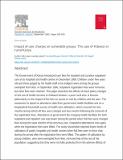| dc.description.abstract | The Government of Kenya introduced user fees for inpatient and curative outpatient care at its hospitals and health centres in December 1989. Children under five years old and those judged by the health staff to be indigent were among the groups exempted from fees. In September 1990, outpatient registration fees were removed, but other fees were retained. This paper describes the effects of these policy changes on the use of health services in Kibwezi division, a poor rural area. It focuses particularly on the impact of the fees on access to care by children and the poor. The assessment is based on attendance data from government health facilities and on a longitudinal household survey of health care utilization, which covered the nine months during which all fees were charged and two months following the removal of the registration fees. Attendance at government fee-charging health facilities for both outpatient and inpatient care was lower during the period when full fees were charged than during the same months of the previous year. Outpatient attendances rose again when the registration fees were lifted. The study households reported lower levels of utilization of public hospitals and health centres when full fees were in force than during the period after the registration fees were lifted. The pattern of utilization by young children, who were exempted from fees, mirrored that of the rest of the population, suggesting that they were not fully protected from the adverse effects of fees. The poorest households made much less use of the fee-charging government facilities than the better-off households. The exemption system did not protect them from the adverse effects of the fees. | en_US |

